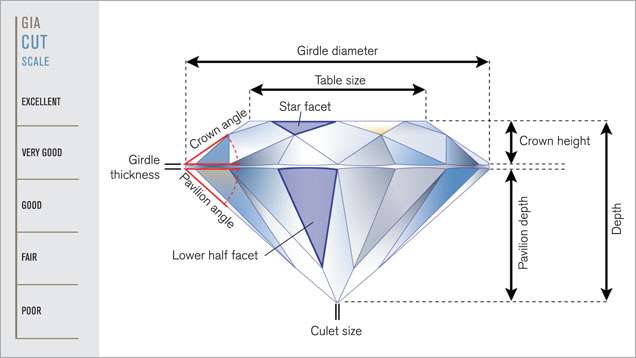Choosing a Diamond: What Matters Most
Diamond Cut
Excellent
Maximum fire and brilliance. Reflects nearly all of the
light that enters the diamond, creating exceptional sparkle and life.
Very Good
Properly reflects most of the light that enters the diamond, producing superior fire and brilliance. Under normal lighting conditions, appears very similar to Excellent Cut, but for a lower price.
The individual components that makeup Diamond Cut include:
- Girdle Width
- Symmetry
- Polish
- Depth%
- Table %, and
- Culet size

Good
Reflects a majority of the light that enters the diamond, for an above-average appearance. An excellent value compared to higher cut
grades.
Fair
Allows much of the light entering the diamond to escape from the sides or bottom, reducing perceived fire and brilliance.
Diamond Color
Natural diamonds contain nitrogen which gives them a natural yellow hue. Color is rated on a scale of D-Z.

Diamond Clarity
Diamonds are rate for clarity based on the number of inclusions. Common types of these inclusions are feathers, crystals, pinpoints, clouds, needles, and twinning wisps.
IF
Flawless and Internally Flawless are the highest clarity grades and indicate no inclusions are visible under 10X magnification, with the Internally Flawless allowing only very minor blemishes.
VVS1 and VVS2
Indicate very, very small inclusions, which might take time to find with a microscope.
VVS1 and VVS2
Indicate very, very small inclusions, which might take time to find with a microscope.
SI1 and SI2
Have small inclusions under 10X magnification but do not affect durability and most are internal and do not break the surface of the diamond. These clarity characteristics are rarely visible to the unaided eye.
I1, I2 and I3
Have inclusions that are obvious with the unaided eye and affect the durability of the stone.

Diamond Carat Size
Not all carats are the same. The cut of a diamond can greatly impact how big the stone appears. This is why, at Fords, we consider Cut to be the most important of the 4Cs, above Carat.

Testimonials
Barry and his exceptional Associates are always there to assist you.
- Gary M
